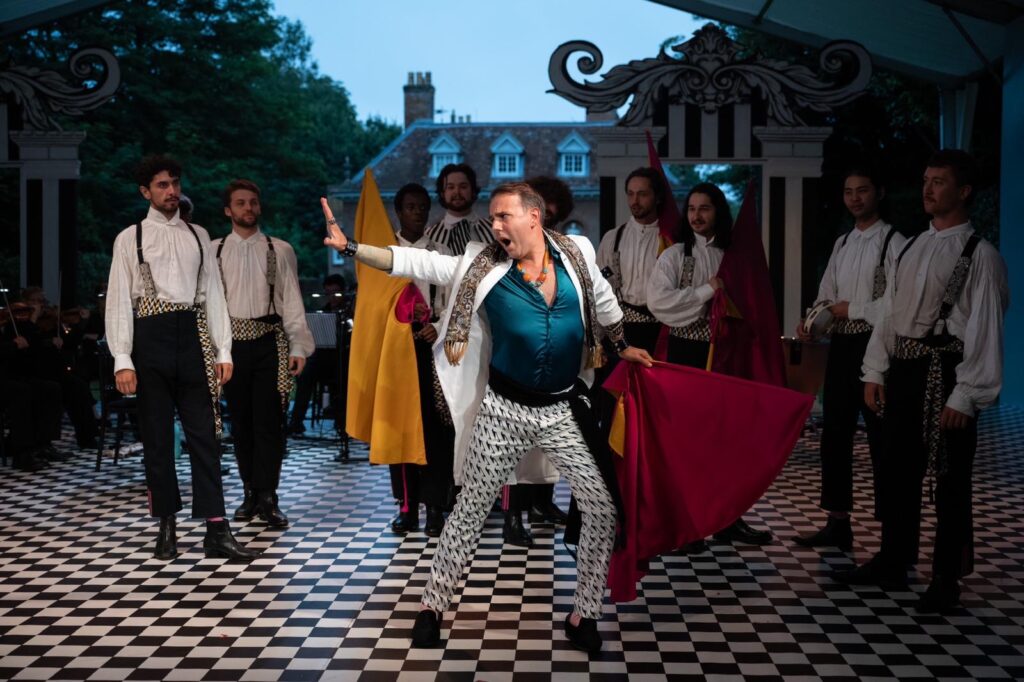The theatre at West Green already has the house as the background beyond the lawn at its open back. Victoria Newlyn’s production of The Barber of Seville, therefore, simply reduces Dr Bartolo’s residence on stage to a group of Palladian arched doorways on a chequered floor, in a somewhat surreal Alice-in-Wonderland character, three of which are rearranged at will. Those at the back and to the sides are surmounted with very curly scrolls, presumably meant to resemble moustaches in reference to the trade of the fixer, Figaro, at the centre of the comedy. The style and brisk, slapstick tempo of the choreography is already set during the Overture when the backstory of Bartolo’s guardianship of Rosina is mimed in a few scenes. The Spanish flavour of the opera’s setting in Seville is evoked by the elements of matador costume which Almaviva’s sidekicks wear, and the full dress of a bullfighter in which Almaviva and Rosina are revealed to each other at the end, once his subterfuges to gain entry to Bartolo’s house have succeeded, and the latter has been well and truly baited. With a minimum of means, therefore, the production nimbly sustains its playful and mischievous temper.

Dominic Sedgwick embodies that spirit as Figaro, quick-witted but discreet and agile in voice so that ‘Largo al factotum’ isn’t strenuous or falsely heroic. Grant Doyle is an energetically neurotic Bartolo, comically vociferous in his recitatives and speedily urgent in his areas – I don’t think I’ve heard a quicker rendition of the tongue-twisting patter in the faster section of ‘A un dottor della mia sorte’. A character of resistance imbues Katie Bray’s account of Rosina, as she colours her sharply etched vocal lines with moody or defiant emphases and swoops, especially in ‘Una voce poco fa’. That may be unconventional, but it runs in line with the expressions of confrontation that she announces in that aria.
Nico Darmanin’s Almaviva presents a contrastingly relaxed temperament with singing that is tender and controlled, if somewhat reedy in tone, rather than a truly lyrical tenor. Although the role of Bartolo’s maid, Berta, is small, Jeni Bern turns in a vivid and ripe interpretation of her one aria.

The performance overall receives similar bubbling impetus from Matthew Kofi Waldren’s conducting and the West Green House Opera Orchestra (in a reduced orchestration by Jonathan Lyness). Although not always absolutely tidy, these smaller forces lend the music an effervescent character. Dominated by strings here in particular, one can hear Rossini’s metier for a ‘pristine’ vocal line (Stendhal’s description of his musical style) that he first honed in writing for similar instrumental forces, rather than for voice, in the six delightful early Sonatas for strings. The Chorus communicate undeniable enthusiasm and unanimity of purpose, a resounding ensemble of individually highly qualified singers on their own terms. As with Falstaff the previous week, Lydia French’s English surtitles add their own idiosyncratic wit, rather than just utilising a standard, old translation, adding to the pleasure of the production. An enchanting evening all round.
Curtis Rogers
The Barber of Seville
Composer: Gioachino Rossini
Libretto: Cesare Sterbini, after Pierre Beaumarchais’s eponymous play
Cast and production staff:
Figaro – Dominic Sedgwick; Almaviva – Nico Darmanin; Rosina – Katie Bray; Bartolo – Grant Doyle; Basilio – Trevor Eliot Bowes; Berta – Jeni Bern; Fiorello – Hector Bloggs; Officer – Dylan Rooner; Ambrogio – Thomas Litchev
Director – Victoria Newlyn; Designer and Costumes – Laura Jane Stanfield; Lighting Designer – Sarah Bath; West Green House Opera Chorus and Orchestra; Conductor – Matthew Kofi Waldren
West Green House Gardens, Hartley Wintney, Hampshire, 28 July 2024
All photos courtesy of West Green House Opera.